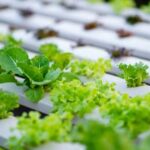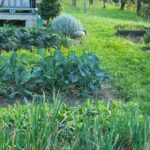Colored mulch has become increasingly popular in gardening circles, as it adds a vibrant touch to outdoor spaces. However, when it comes to vegetable gardens, the question arises whether colored mulch is safe to use. In this article, we will delve into the topic and explore the various aspects surrounding the use of colored mulch in vegetable gardens.
Firstly, let’s understand what colored mulch actually is and why it is used in vegetable gardens. Colored mulch refers to wood chips or shredded bark that have been dyed with pigments to give them a specific color – often hues such as red, black, or brown.
The purpose of using colored mulch in vegetable gardens is twofold: it not only enhances the aesthetic appeal of the garden but also provides several functional benefits. These include conserving soil moisture, suppressing weed growth, regulating soil temperature, and preventing soil erosion.
However, concerns have been raised about the potential risks associated with using colored mulch in vegetable gardens. Some critics argue that certain dyes used in coloring mulch may contain harmful chemicals that could leach into the soil and ultimately be absorbed by plants. This raises questions about food safety and potential health hazards for those consuming vegetables grown in these garden beds.
In the following sections of this article, we will explore the different perspectives on this matter and examine case studies of real-life experiences from gardeners who have used colored mulch in their vegetable gardens. By understanding both sides of the debate and gathering expert insights along the way, we aim to provide you with comprehensive information so you can make an informed decision regarding the safety of using colored mulch in your own vegetable garden.
Understanding the risks of using colored mulch in vegetable gardens
Chemical additives in colored mulch
One of the main concerns surrounding the use of colored mulch in vegetable gardens is the potential harmful effects of the chemical additives used to achieve the vibrant colors. These additives may include dyes, pigments, and preservatives that are not typically found in natural mulches. Some of these chemicals have been shown to leach into the soil over time, raising concerns about their impact on plant growth and health.
Potential toxicity to plants
Another risk associated with colored mulch is its potential toxicity to plants. Research has shown that certain types of mulch, particularly those made from recycled materials or treated with pesticides and herbicides, can release toxins into the soil. These toxins can then be absorbed by vegetables growing in close proximity to the mulch, posing a potential health risk for individuals consuming those vegetables.
Insect attraction and disease transmission
Colored mulch may also attract insects such as aphids, mites, or beetles. These pests can cause significant damage to vegetable plants if left unchecked. Furthermore, some studies suggest that insects could be more attracted to certain colors of mulch, potentially leading to increased pest infestations in garden beds. Additionally, there is a concern that pathogens and diseases can be harbored within colored mulch due to various manufacturing processes or improper storage conditions.
It’s important for gardeners considering the use of colored mulch in their vegetable gardens to weigh these potential risks against any perceived benefits. While it may provide an aesthetically pleasing appearance and help retain moisture and suppress weed growth, there are legitimate concerns about its safety and impact on plant health.
Proceeding with caution and thoroughly researching both the type of colored mulch being considered as well as its source is recommended before incorporating it into a vegetable garden environment.
The debate
The safety of colored mulch in vegetable gardens is a topic that sparks debate among gardeners and experts alike. While some argue that colored mulch can be harmful to crops, others believe it poses no significant risks. This section delves into the different perspectives surrounding the use of colored mulch in vegetable gardens.
Benefits of Colored Mulch
Proponents of colored mulch argue that it offers several benefits for vegetable gardens. Colored mulch, usually made from recycled wood or rubber, adds an aesthetic appeal to the garden beds by providing vibrant colors that can complement the surrounding plants and landscape. In addition to its visual appeal, colored mulch is often touted for its ability to retain soil moisture and regulate temperature, thus creating an ideal environment for plant growth.
Potential Harmful Effects
On the other side of the debate, there are concerns about potential harmful effects associated with using colored mulch in vegetable gardens. One primary concern is chemical leaching. The dyes used to color the mulch may contain chemicals that could leach into the soil over time and be absorbed by vegetables. These chemicals could pose a health risk when consumed by humans.
Another concern is the impact on soil composition. Some studies suggest that certain types of colored mulch may alter the pH level or nutrient content of the soil, which can affect plant growth and health. Additionally, if not properly manufactured or treated, colored mulches may contain toxins or heavy metals that could contaminate the soil and subsequently end up in edible crops.
The Need for Further Research
Given the contrasting opinions on this topic, it is evident that more research is needed to fully understand the safety implications of using colored mulch in vegetable gardens. Studies examining various factors such as dye composition, leaching rates, and long-term effects on crop quality are necessary to provide concrete evidence on whether colored mulch poses significant risks.
In the next section, we will delve into the different types of colored mulch available in the market and explore which options may be safer for vegetable gardens.
Examining the various types of colored mulch available in the market
Colored mulch is a popular choice for vegetable gardens as it not only adds visual appeal but also helps to regulate soil temperature and moisture levels. However, it is important to understand the potential risks associated with using colored mulch in order to make an informed decision for your garden.
When examining the various types of colored mulch available in the market, it is crucial to consider the materials used to create the color. Some colored mulches are made with organic dyes or natural pigments, while others may contain synthetic dyes or chemicals that could potentially be harmful to plants and soil.
In terms of safety for vegetable gardens, it is generally recommended to opt for colored mulch made from organic dyes or natural pigments. These types of mulches are typically derived from plant-based sources such as cocoa shells or shredded wood and do not pose significant risks to plants or soil health.
On the other hand, colored mulches that contain synthetic dyes or chemicals may leach harmful substances into the soil over time, which can negatively impact plant growth and potentially contaminate edible vegetables.
| Type of Colored Mulch | Safety for Vegetable Gardens |
|---|---|
| Colored Mulch with Organic Dyes/Natural Pigments | Generally safe; derived from plant-based sources |
| Colored Mulch with Synthetic Dyes/Chemicals | Potential risk; may leach harmful substances into soil over time |
It is essential for gardeners to check the labeling and product information when purchasing colored mulch for their vegetable gardens. Look for products that explicitly state the use of organic dyes or natural pigments. Additionally, conducting thorough research and seeking advice from horticulturists or gardening experts can provide further guidance on the safety of specific colored mulch options.
Factors to consider when using colored mulch in vegetable gardens
When considering the use of colored mulch in vegetable gardens, there are several factors that gardeners must take into consideration. One important factor to assess is the soil composition of the garden. Different types of colored mulch may interact differently with different soil types, which can potentially impact plant growth and health. For example, clay soils tend to retain more water, so using colored mulch that does not allow for proper drainage may lead to waterlogged soil and root rot.
Another factor to consider is the potential for chemical leaching from the colored mulch into the soil. Some colored mulches contain dyes or chemicals that could leach into the soil over time and be taken up by the plants.
These chemicals could potentially have harmful effects on both plant health and human consumption if they make their way into edible crops. It is important to research and select colored mulches that are labeled as safe for vegetable gardens and do not contain any hazardous or toxic substances.
In addition to soil composition and potential chemical leaching, it is also crucial to evaluate other aspects such as maintenance requirements, compatibility with irrigation systems, and any specific instructions from the manufacturer. Proper installation techniques should be followed to ensure optimal performance of the colored mulch in vegetable gardens. Regular monitoring of the garden’s condition and addressing any negative impacts promptly can help mitigate any potential risks associated with using colored mulch.
By carefully considering these factors when using colored mulch in vegetable gardens, gardeners can make informed decisions about its suitability for their specific needs. Taking a cautious approach and being proactive in researching safe options can help create a healthy growing environment for vegetables while still enjoying the benefits that colored mulch can bring in terms of weed suppression, moisture retention, temperature regulation, and aesthetic appeal.
Case studies
Case studies provide valuable insights into the real-life experiences of gardeners who have used colored mulch in their vegetable gardens. These accounts can help to shed light on the potential benefits and drawbacks of using colored mulch, as well as inform gardeners about best practices for its use.
One gardener, Sarah, decided to use black colored mulch in her vegetable garden after hearing positive reviews from other gardening enthusiasts. She found that the black mulch not only added a striking visual appeal to her garden but also helped to suppress weed growth. Sarah noticed that her vegetables grew healthier and more vigorous compared to previous years when she had not used colored mulch.
However, she did mention that during hot summers, the black mulch got extremely hot and caused some damage to her plants when they came into direct contact with it. To mitigate this issue, she started watering her garden more frequently and providing shade during the hottest parts of the day.
On the other hand, another gardener named Mike had a different experience with colored mulch. He opted for red-colored mulch in his vegetable garden because he believed it would complement his surrounding landscaping. However, Mike noticed that his plants struggled to establish deep root systems when grown with colored mulch.
This hindered their ability to absorb water and nutrients effectively, resulting in stunted growth. After consulting with a gardening expert, Mike learned that certain types of colored mulch can alter soil conditions and affect root development. He decided to remove the red-colored mulch from his vegetable garden and switch back to traditional organic mulching materials.
These case studies show that while some gardeners have experienced success with colored mulch in their vegetable gardens, others have encountered challenges or negative effects. It is essential for gardeners to understand their specific circumstances and carefully consider factors such as soil composition, climate conditions, plant varieties, and maintenance practices before deciding whether or not to use colored mulch.
Expert opinion
One of the crucial aspects of understanding the safety of colored mulch for vegetable gardens is seeking expert opinions from horticulturists and gardening experts. These professionals bring valuable insights and recommendations based on their extensive knowledge and experience in the field. Their opinions can help gardeners make informed decisions about whether or not to use colored mulch in their vegetable gardens.
According to many horticulturists, using colored mulch in vegetable gardens can be safe as long as certain precautions are taken. They emphasize the importance of choosing high-quality colored mulch that is specifically designed for use in gardens. It is recommended to opt for products that are made from non-toxic dyes and natural materials, such as dyed wood chips or bark mulches.
Gardening experts also stress the significance of considering the soil composition before using colored mulch. Some types of colored mulch may alter the pH levels of the soil over time, which can impact plant growth and nutrient absorption. Therefore, conducting a soil test prior to using colored mulch is highly recommended. This will help determine if any adjustments need to be made to maintain optimal growing conditions for vegetables.
In addition, experts advise gardeners to stay vigilant about potential chemical leaching from colored mulch into the soil. It is vital to ensure that the chosen colored mulch product does not contain any harmful substances or chemicals that could leach into the ground and contaminate growing vegetables. Regular monitoring of plants and observing any signs of distress or poor growth can help identify and address any issues promptly.
Overall, while there may be differing perspectives, horticulturists and gardening experts generally agree that with proper precautions and attention to details like product quality, soil composition, and potential chemical leaching, using colored mulch in vegetable gardens can be safe and effective. However, it is always necessary for gardeners to conduct thorough research, seek professional guidance when needed, and closely monitor the health and growth of their vegetable plants when using colored mulch.
Best practices for using colored mulch in vegetable gardens
Using colored mulch in vegetable gardens can be an effective way to enhance the visual appeal of the garden while also providing numerous benefits such as weed suppression, moisture retention, and temperature regulation. However, it is important to follow best practices when using colored mulch to ensure its safety and maximize its effectiveness.
Proper application techniques are crucial when using colored mulch in vegetable gardens. Before applying the mulch, it is important to prepare the soil properly by removing any weeds or debris and ensuring that it is well-amended with organic matter.
Once the soil is prepared, the mulch should be spread evenly around the plants, leaving a small gap around the stems to allow for air circulation. It is also important to apply a layer of mulch that is neither too thick nor too thin – a thickness of around 2-3 inches is generally recommended.
Supervision and regular maintenance are also key aspects of using colored mulch in vegetable gardens. Gardeners should regularly monitor the condition of the mulch and make sure that it remains intact and in good condition. Any signs of deterioration or mold growth should be addressed promptly to prevent any potential harm to the vegetables. Additionally, proper watering techniques should be followed to ensure that excessive moisture does not accumulate in the mulch layer, leading to fungal growth or root rot.
By following these best practices for using colored mulch in vegetable gardens, gardeners can optimize its benefits while minimizing any potential risks. Proper application techniques will ensure that the mulch enhances rather than hinders plant growth, while supervision and maintenance will help detect any issues early on and prevent any adverse effects on vegetables.
Alternative options to colored mulch for vegetable gardens
There are alternative options to using colored mulch in vegetable gardens that are both safe and effective. For those who are concerned about the potential risks associated with colored mulch, organic alternatives can provide a natural and eco-friendly option.
One such alternative is using straw as mulch in vegetable gardens. Straw is readily available and inexpensive, making it a popular choice among gardeners. It helps suppress weeds, retain moisture, and regulate soil temperature. Additionally, straw breaks down over time and adds organic matter to the soil, improving its overall health.
Another organic option for mulching vegetable gardens is using compost. Compost is rich in nutrients and enhances soil fertility while also retaining moisture and suppressing weeds. It can be made at home using kitchen scraps, yard waste, and other organic materials. Alternatively, commercially-produced compost can be purchased from garden centers or local farms.
Grass clippings can also be used as mulch in vegetable gardens. It is important to use grass clippings that have not been treated with chemicals such as herbicides or pesticides. Grass clippings help retain moisture in the soil and add nitrogen as they break down.
Wood chips from untreated wood can be used as an alternative to colored mulch. They provide weed suppression, moisture retention, and contribute to soil nutrition as they decompose slowly over time.
Conclusion
In conclusion, the use of colored mulch in vegetable gardens has been a topic of debate among gardeners and experts. While colored mulch can enhance the aesthetic appeal of the garden and provide certain benefits such as weed suppression and moisture retention, there are potential risks that need to be considered.
The main concern with colored mulch is the possibility of chemical leaching into the soil and ultimately into the vegetables. Different types of colored mulch have varying levels of safety, with some containing dyes that may contain potentially harmful substances. It is important for gardeners to carefully examine the ingredients and composition of colored mulch before using it in their vegetable gardens.
Soil composition also plays a crucial role in determining the safety of colored mulch. If the soil already contains high levels of contaminants or if there are concerns about chemical runoff from nearby sources, it may be best to avoid using colored mulch altogether.
While case studies and expert opinions provide valuable insights into the use of colored mulch, it is ultimately up to individual gardeners to weigh these perspectives against their own circumstances and preferences. If one decides to use colored mulch, proper application techniques, supervision, and maintenance should be followed to minimize potential risks.
Considering all factors, including soil composition, potential chemical leaching, available alternatives, and personal preferences, it is recommended that gardeners take a cautious approach when using colored mulch in vegetable gardens. Exploring organic alternatives that are safe and effective may be a better option for those who prioritize the health and safety of their crops. Overall, proper research and analysis should guide decision-making when it comes to incorporating colored mulch into vegetable gardens.
Frequently Asked Questions
Is it OK to put dyed mulch in a vegetable garden?
It is generally not recommended to use dyed mulch in a vegetable garden. Dyed mulch is typically made from shredded wood or bark that has been colored with artificial dyes.
These dyes can potentially contain chemicals that may leach into the soil over time, which can be harmful to plants and vegetables. While the exact composition of these dyes varies, it is best to err on the side of caution when it comes to growing food crops and opt for natural, untreated mulch instead.
What color mulch is best for vegetable garden?
When choosing a color for mulch in a vegetable garden, it is important to prioritize functionality rather than aesthetics. The color of the mulch should ideally reflect sunlight and promote healthy plant growth.
Generally, black or dark-colored mulch is considered most effective as it absorbs more heat from the sun, helping to warm the soil earlier in the season and extend the growing season for vegetables. This can be particularly beneficial in cooler regions with shorter growing seasons.
Why not to use dyed mulch?
There are several reasons why using dyed mulch is not recommended. Firstly, as previously mentioned, dyed mulch often contains artificial dyes that may contain toxic substances which can eventually leach into the soil and be taken up by plants. This poses a potential health risk if consumed by humans or animals.
Furthermore, dyed mulch often lacks the organic matter found in natural options such as wood chips or straw, which provide valuable nutrients and improve soil structure over time. Additionally, dyed mulch tends to break down at a slower rate compared to natural options, impeding nutrient cycling and potentially leading to imbalances in the soil ecosystem of a vegetable garden. Overall, it is best to opt for untreated natural mulches that offer sustainable benefits without any potential chemical risks associated with dyed alternatives.

If you’re looking to get into vegetable gardening, or are just looking for some tips on how to make your current garden better, then you’ve come to the right place! My name is Ethel and I have been gardening for years. In this blog, I’m going to share with you some of my best tips on how to create a successful vegetable garden.





